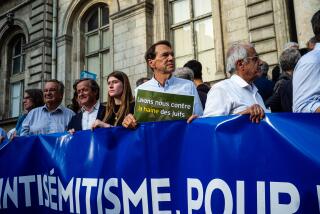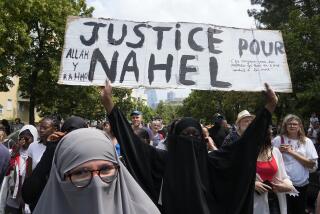Review: ‘Massacre’ a sobering chronicle of the Paris Commune
- Share via
The Paris Commune was a defining moment for the European left: the first self-consciously socialist uprising — as opposed to the liberal nationalist revolutions of 1830 and 1848 — that aimed to put working-class people in control of industry and government.
The Commune’s savage suppression in May 1871 by France’s fledgling Third Republic buttressed the international socialist movement’s contention that bourgeois democracies were as hostile to workers’ rights as any monarch. Because the Commune enabled activists at the local level to assert considerable political and social authority, it remains an icon to contemporary free-form movements like Occupy Wall Street that seek to avoid hierarchies and let power flow from the grass roots.
Yale historian John Merriman briefly covers the Commune’s attempts to help ordinary Parisians in his new book, “Massacre: The Life and Death of the Paris Commune,” which mentions decrees improving working conditions, establishing cooperative workshops with elected leadership and forbidding evictions for nonpayment of rent. He tips his hat to this “time of big dreams,” when women claimed equality with men and citizens played an active role in local governing bodies distributing food and fuel to the poor.
Yet his primary emphasis is on the military struggle the Commune was fated to lose. Fully half the text chronicles the “Bloody Week” of May 21-28, 1871, during which the Third Republic’s army retook Paris, slaughtering civilians and combatants alike. Merriman’s main point is not about socialism but about government.
Before he gets to his explanation of how “the murderous, systemic, state repression [of the Commune] helped unleash the demons of the twentieth century,” Merriman offers an overview of Paris during the Second Empire, a playground for the rich and a hellhole for the poor. The prosperous western neighborhoods boasted elegant shops, cafes and residences; proletarian eastern Paris was filthier and more crowded than ever. Class consciousness and class hatred seethed on both sides of the social divide, which had grave consequences when the Second Empire collapsed in wake of the French army’s dismal performance in the Franco-Prussian War.
The hastily formed Third Republic was forced to sign a humiliating, unpopular peace treaty in February 1871. Most Parisians were much more radical than the new regime, and calls for popular sovereignty and municipal self-rule were heard in the streets months before February elections returned a conservative National Assembly that Parisians feared would restore the monarchy.
Their fears were reinforced by the National Assembly’s move on March 10, 1871, to Versailles, former residence of French kings. The National Guard, a citizen militia grown increasingly militant during the war, moved a large number of cannons into the working-class strongholds of Montmartre and Belleville. When the Versailles government dispatched troops to seize them on March 18, crowds blocked the way, and the soldiers refused to fire on the people. That night, a red flag flew above the city hall; the Paris Commune was officially declared on March 28.
“Never has a revolution so surprised revolutionaries,” said Louise Michel, one of the handful of Communards who get brisk thumbnail sketches from Merriman. The National Guard’s Central Committee was briefly in charge by default and continued to act as “guardian of the revolution” after municipal elections created a governing council for the Commune. Merriman views this divided leadership as a major factor in the disorganization that rendered the Commune vulnerable when the government launched a full-scale invasion of Paris on May 21.
About 17,000 men, women and children were killed by the Versaillais soldiers. Merriman’s nearly blow-by-blow account of the street fighting is vivid — including grisly details like the army’s use of machine guns for mass executions — and he persuasively argues that the regular French army’s recent humiliation by the Prussians made officers particularly vengeful toward the Communards, whom they regarded as common criminals. He notes the use of words like “vermin” and “purify,” which unsettlingly link Bloody Week with such subsequent atrocities as the Holocaust.
That link is, for Merriman, a crucial aspect of the Commune’s historical significance, and his provocative thesis deserves consideration. A better balanced book would have spent more time assessing the Communards’ admittedly fleeting effort to build a more egalitarian system. Their vision of workers’ right to control the conditions of their labor and claim a greater share of its profits profoundly influenced the socialist political parties that took shape at the end of the 19th century and ultimately — through the electoral process this time — reshaped European society.
But no form of government guarantees economic or social equality, as we’ve seen in the struggles of the democracies born in the Arab Spring. Merriman’s portrait of the Paris Commune focuses unduly on its violent demise, but his sobering chronicle of just how far an allegedly democratic state was prepared to go to protect itself against its own people has grim resonance today.
Smith is a contributing editor of the American Scholar and the author of “Real Life Drama: The Group Theatre and America, 1931-1940.”
Massacre: The Life and Death of the Paris Commune
John Merriman
Basic Books: 360 pp., $29.99
More to Read
Sign up for our Book Club newsletter
Get the latest news, events and more from the Los Angeles Times Book Club, and help us get L.A. reading and talking.
You may occasionally receive promotional content from the Los Angeles Times.










